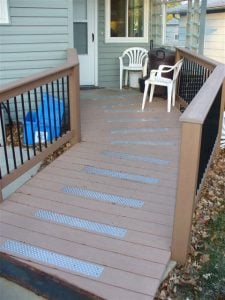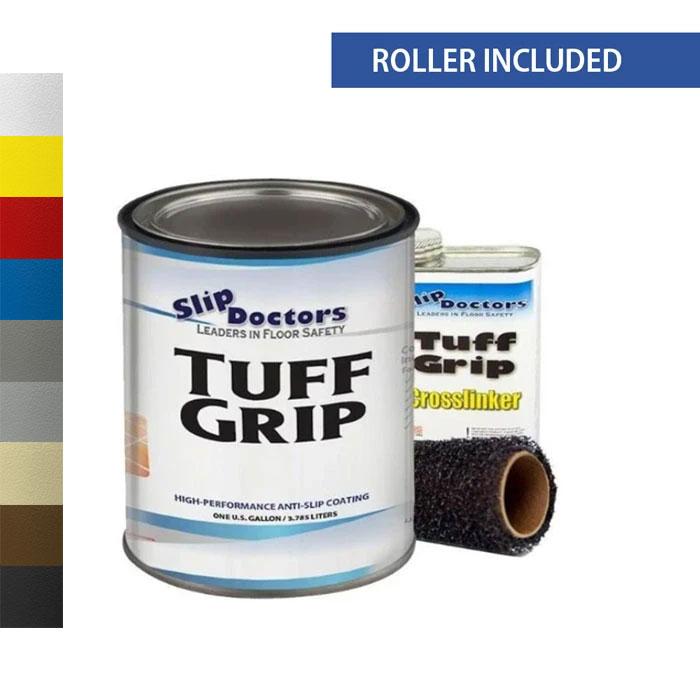Customized Stop-the-Slip Solutions
For Your Unique Conditions
Problem Area: Slippery Outdoor Wood Ramp
When on an inclined surface, such as a wooden ramp, the chances of slipping and falling are greatly increased. With weather conditions like rain, sleet, and snow, or debris like ice or fallen leaves, ramps can become a dangerous slip and fall hazard.
It is crucial to prevent slip, trip, and fall accidents before they happen. Don’t wait until an injury occurs on your wooden wheelchair ramp to start employing safety measures. Your four graded options below will outline the solutions best suited for the wooden ramp at your home or business.

Your Stop-the-Slip Solutions Graded:
Handi-Treads: A-
For the most part, grit tape that you can buy at Home Depot or Amazon is not suitable for outdoor use. There is no tape-based adhesive that can realistically stand up to rain, snow, and the inevitable heat and thaw cycles.
In a limited number of outdoor wooden ramp situations, non-slip grip tape can be a short-term solution to reduce slips and falls. Rain and frost are easily dealt with by grit embedded into the tape. However, the grit tape will not be able to maintain its anti-slip properties once the first snow falls. Snow shovels cannot be used with grit tape without damaging them, so the winter season is usually the end of the grit tape’s life. Not only will the snow shovel pull the tape right off of the ramp if you catch an edge, but even a plastic blade will quickly defeat the thin coating protecting the aggregate.
The proper installation of non-slip grip tape requires a bit of effort as detailed here. First, it’s important that the wood surface, whether stained or painted, is clean, dry, and in good shape. Heavily grained, uneven, or splintering wood makes it difficult for the tape adhesive to completely bond, and the effective life of grip tape is directly related to how carefully and completely it has adhered to the steps.
There’s no maintenance that can or should be done to the tape other than to be very careful of the edges and corners, which can be easily pulled up. Once a corner or edge begins to peel, the grip tape will quickly deteriorate.
If you’re comfortable with a lifespan on outdoor wood of six months to a year, grit tape can be an inexpensive temporary solution for the wooden ramp at your home or business.



Total Score: A-
Effectiveness: A
Installation & Maintenance: A
Durability: A
Initial Price: C
Long-Term Value: A
Non-Slip Grit Tape: D-
For the most part, grit tape that you can buy at Home Depot or Amazon is not appropriate for outdoor use. There is no tape-based adhesive that can realistically stand up to rain, snow and the inevitable heat and thaw cycles.
In a limited number of outdoor wooden ramp situations, non-slip grip tape can be a short-term solution to reduce slips and falls. Rain and frost are easily dealt with by grit embedded into the tape. However, once it snows the trouble really begins. You simply can’t use a snow shovel on grit tape. Not only will you pull the tape right off the stairs if you catch an edge, but even a plastic blade will quickly defeat the thin coating protecting the aggregate.
The proper installation of non-slip grip tape does require a bit of effort as detailed here. First, it’s important that the wood surface, whether stained or painted, is clean, dry and in good shape. Heavily grained, uneven or splintering wood makes it difficult for the tape adhesive to completely bond, and the effective life of grip tape is directly related to how carefully and completely it has been adhered to the steps.
There’s no maintenance that can or should be done to the tape other than to be very careful of the edges and corners, which can be easily pulled up. Once a corner or edge begins to peel, the grip tape will quickly deteriorate.
If you’re comfortable with a lifespan on outdoor wood of six months to a year, grit tape can be an inexpensive temporary solution.

Total Score: D-
Effectiveness: D
Installation & Maintenance: C
Durability: F
Initial Price: A
Long-Term Value: F
Heavy Duty Rubber Runners: C-
Heavy-duty rubber runners can be an effective, temporary way to safely increase the traction on a wood ramp if they are ADA compliant.
The Americans with Disabilities Act requires that mats be attached securely to the ramp and have beveled edges if over 1/4″ in thickness. This means that mats cannot be simply thrown down on ramps without causing a slip and fall hazard in themselves.
While rubber runners handle moisture with ease, they must be kept free of snow if they are to be effective in the winter. The channels or cut-outs that provide traction in wet conditions can also accumulate ice and snow, turning them into slip hazards and making them difficult to clean. Care must be taken when using a snow shovel with rubber runners as even a plastic blade can cut the rubber and displace the entire runner. Snow is best removed from the heavy-duty rubber runners by picking them up off the ramp and shaking the snow off. This procedure must be repeated several times during heavy snow, increasing both the time and cost required to use them as a slip-and-fall solution.
Rubber mats must also be cleaned fairly frequently, as dirt and debris are easily caught and captured in the grooves or holes, reducing the traction and drainage of the runner.
Depending upon the thickness and quality of the rubber mat material, you can expect the mat to last 2 to 4 years at your home or business.

Total Score: C-
Effectiveness: D
Installation & Maintenance: D
Durability: C
Initial Price: B
Long-Term Value: C
Grit Paint: C+
A top-notch grit paint like the Slip Doctor Dura Grip and Tuff Grip traction paints can dramatically improve the safety of a long, wooden outdoor ramp if it’s applied meticulously, and maintained properly. Like grit tape, non-slip paints include an aggregate that creates traction. The best anti-slip paints contain aluminum oxide or carborundum that are encapsulated in the paint, creating a rough, slip-resistant surface. Grit paint is effective in wet weather and frost, but it’s ineffectual with snow.
Longevity is another challenge with anti-slip paint when used on a wooden ramp. The incline of the ramp creates much more pressure between shoes and, more often than not, the wheels of wheelchairs, hand trucks, and dollies. This increased pressure leads to a shorter life and the need to repaint the ramp after two to three years. There is no maintenance that can be performed on anti-slip paints to increase their longevity other than regular sweeping.
If your home or business is located in a place that receives snow, you need to be very careful not to aggressively shovel a ramp painted with grit paint. While the epoxy or enamel coating is durable under wheelchairs and normal foot traffic, it’s no match for an aluminum or even plastic snow shovel. Once you start to scrape away the thin paint layer covering the aggregate, the system will quickly degrade.
The cost of a high-quality grit paint can run between $60 and $120 a gallon. In addition, you’ve got the consumable cost of paintbrushes or rollers, trays, sandpaper, masking tape, and drop cloths that will likely cost an additional $40. When all costs are factored in, and depending upon the length of the ramp, grit paint can be one of the more expensive non-slip solutions for the wooden ramp at your home or business.


